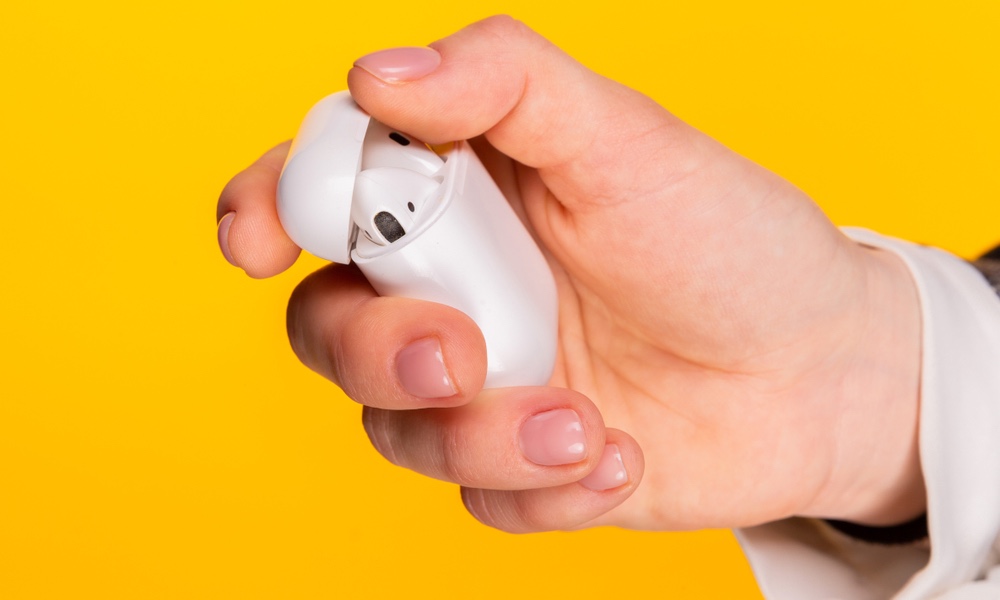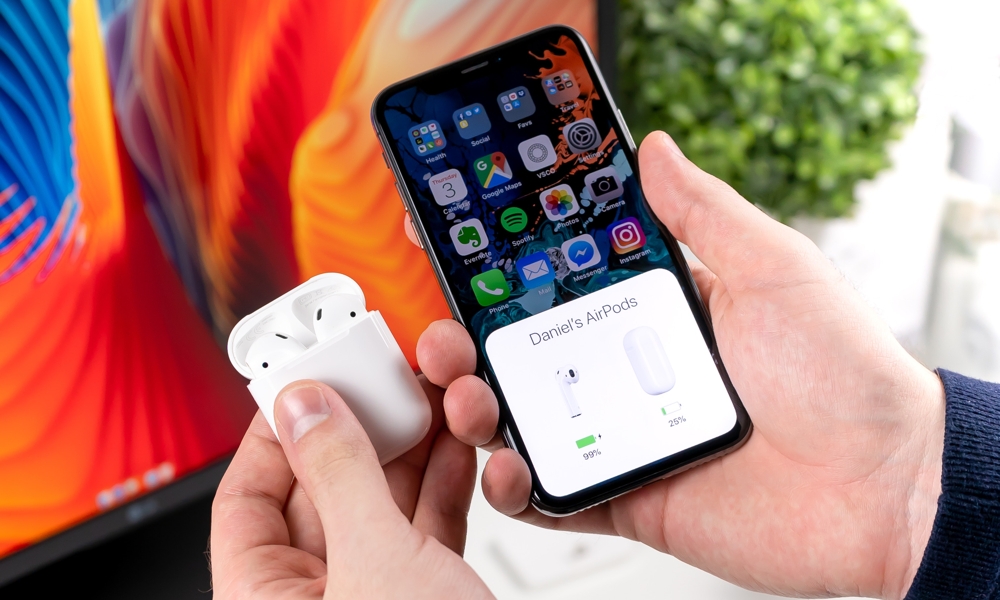Are Your AirPods Legitimate or Fake? Here’s How You Can Tell the Difference
 Credit: Burdun Iliya / Shutterstock
Credit: Burdun Iliya / Shutterstock
Toggle Dark Mode
After a report last week that US Customs has seized hundreds of thousands of counterfeit AirPods, you may be asking yourself how you can be sure that you’re buying legitimate AirPods — or even if the ones you already have were made by Apple rather than some sketchy foreign company trying to make a fast buck.
Unfortunately, it may be harder than you think to tell if the “AirPods” you already own were truly made by Apple.
Even though nobody but Apple should be able to duplicate the pairing process and features powered by Apple’s W1/H1 chips, it seems that some clever counterfeiters have figured out how to trigger the automatic pairing prompts in iOS — even on AirPods that are clearly fake.
It’s not entirely clear how they’ve managed to do this, or whether it’s a problem in every version of iOS, but it’s rather surprising that it happens at all, since Apple’s W1/H1 chips use an encrypted handshake with the iPhone and iOS in order to identify themselves.
In fact, Apple has been using “authentication chips” for its accessories since long before the first iPhone — even in the days of the iPod’s 30-pin Dock Connector, there were certain types of wired accessories that required special Apple-made chips be recognized as authorized accessories.
There’s a similar secure pairing process in Apple’s AirPods that should prevent counterfeit accessories from showing up as AirPods in iOS (shown above), but clearly some counterfeiters have either managed to acquire some W1/H1 chips that fell off the back of a truck, or they’ve figured out some way around it.
We were aware of a bug in early 2017 that allowed this to happen after the very first AirPods were released, but it was quickly patched by Apple. However, we’ve seen it recur a few times with specific counterfeit AirPods, which suggests that Apple is playing a cat-and-mouse game with hackers.
Either way, this means you won’t be able to rely on the fact that your iPhone recognizes your earbuds as AirPods to guarantee that they’re authentic.
Signs of Fake AirPods | How to Know If Your AirPods Are Fakes
That said, there are several other tell-tale signs to look for if you already own a pair of AirPods and you’re concerned about their authenticity:
- Coloured LEDs. Some of the fake AirPods we’ve seen have odd blue and red LEDs on them — lights that are not found on any version of AirPods made by Apple. Legitimate AirPods have no LEDs anywhere on the earbuds themselves, and only a single charging/pairing status LED on the case, which lights up either white, amber, or green — but never red or blue.
- Physical buttons. AirPods do not have any physical buttons. Standard AirPods rely on accelerometer-based tap detection, while AirPods Pro allow you to squeeze the stems. This means that if there are buttons on your AirPods, they weren’t put there by Apple.
- Feel of the plastic. Genuine Apple AirPods are made from shiny hard plastic that is smooth to the touch and not flexible at all — they should not feel rubbery. Many fake AirPods are made out of far cheaper materials.
- Charging Port. Apple controls its Lightning connector very tightly, and while some counterfeit AirPods have tried to replicate this, most just take the easy route and put a micro USB port in the bottom of the charging case, which is a dead giveaway.
- Sound quality. Real AirPods sound much better than most fakes, simply because it’s not worth it for counterfeiters to put the effort into decent sound quality. This is especially true for AirPods Pro with their Transparency and Active Noise Cancellation features. Even if you’ve ended up with a really clever set of fakes that trick your iPhone into showing the Transparency and ANC settings — which most won’t do — you’ll generally find that these options work very poorly, if they work at all.
- Check the serial number. You can find the serial number for your AirPods by going into the iPhone Settings app while your AirPods are connected, and then choosing General->About. Your AirPods should appear listed at the bottom of the Wi-Fi and Bluetooth settings. You can copy the serial number from here and paste it into Apple’s Check Your Service and Support Coverage page at checkcoverage.apple.com to find out if it’s legit. The serial number should show here as valid, and the purchase date should reflect the approximate date you actually bought them.
- Pairing Process. Despite the fact that some of the really good fakes have managed to duplicate the pairing process, these are the exceptions. So, if setting up your AirPods with your Apple device requires that you jump through the same hoops that would be required for any other set of Bluetooth headphones — putting them into a special “pairing mode” and then going into your Bluetooth settings to find and pair them — then there’s a very good chance that you don’t have real AirPods, no matter how much they might look like AirPods on the outside. Further, even if it looks like your earbuds are using the Apple pairing process, there will often still be more subtle signs that they’re cheating, such as asking you to reset your brand new AirPods before you can pair them, or randomly requiring them to be re-paired every so often.
Note that there are reasons why legitimate Apple AirPods may not automatically pair with your iPhone right away. For example, if you have a much older iPhone model, or you’re running an ancient version of iOS that doesn’t recognize your AirPods. But given a modern iPhone running iOS 14 — which means any iPhone made since 2015 — legit AirPods really should just offer the seamless pairing experience that they’re so well known for.
The only other common reason why you may not get automatic pairing is if you’ve bought the AirPods second-hand — meaning they’ve already been paired with someone else’s iPhone. Even in this case, you should see a message on your screen letting you know that your AirPods are paired with another device, but either way, you can simply follow Apple’s instructions to reset them just to be sure.
Shopping for AirPods
Of course, it’s a bit more difficult to tell if a set of AirPods are the real deal when you don’t yet have them in your hands. Counterfeiters can be very clever, and we’ve seen AirPods that even feature packaging that looks extremely similar to Apple’s own.
While it’s possible for a reasonably trained eye to tell the difference in these cases, we wouldn’t blame anybody for being duped.
However, there are a few simple red flags to be on the lookout for when shopping for AirPods:
- Deals that sound too good to be true usually are. AirPods aren’t just expensive because Apple sells them in its own retail stores. In fact, Apple’s so-called “wholesale” prices on almost all of its products aren’t all that much less than the retail price. This means that you’ll rarely find steep discounts on legitimate Apple products — especially brand-new ones.
- Consider the seller’s reputation. Obviously, Apple won’t be selling counterfeit AirPods, and it’s a very safe bet that you won’t find counterfeits at places like Best Buy or Walmart — at least not in person. Be more cautious when buying online, however, since most major retailers now have “marketplace” sellers, similar to Amazon — just because you’re buying from Best Buy’s or Walmart’s websites doesn’t mean that’s who is selling you the product. Check the seller’s reputation, and don’t just rely on the retailer’s name.
- Check the serial number. If you’re buying in person from a retailer that you’re not quite sure about, check the packaging before finalizing your purchase. As we mentioned earlier, you can also validate the serial number on the outside of the box with a quick trip to Apple’s Check Your Service and Support Coverage page at checkcoverage.apple.com. While it’s possible that the counterfeiter is using a valid serial number that was stolen from a legitimate set of AirPods, details like the purchase date will give you a clue — especially if the AirPods you’re buying are supposed to be new.
Note that you may still be able to find a few deals on brand-new first-generation AirPods — the 2016 models — but we generally recommend steering clear of these even if they are legit. Since they were replaced by the second-generation AirPods over two years ago, this means that they’ve been sitting on a shelf somewhere for at least that long, and probably longer, so you may not get the battery life you’d expect.
Buying Refurbished AirPods
Another way that counterfeiters try to dupe their victims is by claiming that the “AirPods” they’re selling are second-hand or simply “refurbished” or “open box” stock.
In this case, you can still check the serial number if you can get your hands on it, although the purchase date may not be as reliable if they’ve already been used by somebody else.
It’s also worth keeping in mind that, as of this writing, Apple doesn’t offer refurbished AirPods at all, although other retailers might. Amazon does sell them in its “Renewed” store in certain markets, and if they’re legitimately “Sold and Shipped by Amazon” then you can at least trust that they’ve been tested, and you have a 90-day return policy to fall back on.
Again, however, just like buying new AirPods, check the seller’s information and reputation. Third-party sellers can throw words like “renewed” or “refurbished” into their listings, and counterfeiters can use this as an excuse to justify seemingly great deals or shipping their fake AirPods out in a plain brown box rather than original packaging.
While online retailers like Amazon should stand behind their return policies even for third-party sellers, in our experience that can sometimes get complicated. It’s far better to avoid the hassle entirely by exercising some due caution up-front and avoiding deals that look too good to be true.







